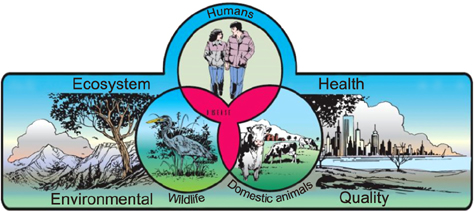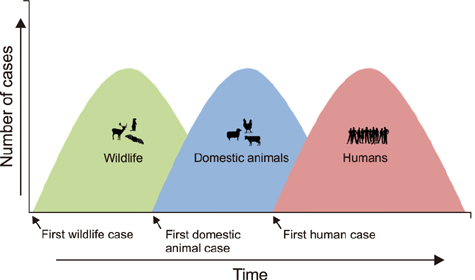J Vet Sci.
2017 Aug;18(S1):263-268. 10.4142/jvs.2017.18.S1.263.
Optimization of human, animal, and environmental health by using the One Health approach
- Affiliations
-
- 1USGS National Wildlife Health Center, Madison, WI 53711, USA. jsleeman@usgs.gov
- 2USDA APHIS Wildlife Services, National Wildlife Research Center, Fort Collins, CO 80521-2154, USA.
- KMID: 2412550
- DOI: http://doi.org/10.4142/jvs.2017.18.S1.263
Abstract
- Emerging diseases are increasing burdens on public health, negatively affecting the world economy, causing extinction of species, and disrupting ecological integrity. One Health recognizes that human, domestic animal, and wildlife health are interconnected within ecosystem health and provides a framework for the development of multidisciplinary solutions to global health challenges. To date, most health-promoting interventions have focused largely on single-sector outcomes. For example, risk for transmission of zoonotic pathogens from bush-meat hunting is primarily focused on human hygiene and personal protection. However, bush-meat hunting is a complex issue promoting the need for holistic strategies to reduce transmission of zoonotic disease while addressing food security and wildlife conservation issues. Temporal and spatial separation of humans and wildlife, risk communication, and other preventative strategies should allow wildlife and humans to co-exist. Upstream surveillance, vaccination, and other tools to prevent pathogen spillover are also needed. Clear multi-sector outcomes should be defined, and a systems-based approach is needed to develop interventions that reduce risks and balance the needs of humans, wildlife, and the environment. The ultimate goal is long-term action to reduce forces driving emerging diseases and provide interdisciplinary scientific approaches to management of risks, thereby achieving optimal outcomes for human, animal, and environmental health.
Keyword
MeSH Terms
Figure
Reference
-
1. Abbott RC, Osorio JE, Bunck CM, Rocke TE. Sylvatic plague vaccine: a new tool for conservation of threatened and endangered species? Ecohealth. 2012; 9:243–250.
Article2. Bevins SN, Dusek RJ, White CL, Gidlewski T, Bodenstein B, Mansfield KG, DeBruyn P, Kraege D, Rowan E, Gillin C, Thomas B, Chandler S, Baroch J, Schmit B, Grady MJ, Miller RS, Drew ML, Stopak S, Zscheile B, Bennett J, Sengl J, Brady C, Ip HS, Spackman E, Killian ML, Torchetti MK, Sleeman JM, Deliberto TJ. Widespread detection of highly pathogenic H5 influenza viruses in wild birds from the Pacific Flyway of the United States. Sci Rep. 2016; 6:28980.
Article3. Blehert DS, Lorch JM, Ballmann AE, Cryan PM, Meteyer CU. Bat white-nose syndrome in North America. Microbe. 2011; 6:267–273.
Article4. Boyles JG, Cryan PM, McCracken GF, Kunz TH. Economic importance of bats in agriculture. Science. 2011; 332:41–42.
Article5. Bradley CA, Altizer S. Urbanization and the ecology of wildlife diseases. Trends Ecol Evol. 2007; 22:95–102.
Article6. Brown C. Emerging zoonoses and pathogens of public health significance--an overview. Rev Sci Tech. 2004; 23:435–442.
Article7. Cardinale BJ, Duffy JE, Gonzalez A, Hooper DU, Perrings C, Venail P, Narwani A, Mace GM, Tilman D, Wardle DA, Kinzig AP, Daily GC, Loreau M, Grace JB, Larigauderie A, Srivastava DS, Naeem S. Biodiversity loss and its impact on humanity. Nature. 2012; 486:59–67.
Article8. Daszak P, Cunningham AA, Hyatt AD. Anthropogenic environmental change and the emergence of infectious diseases in wildlife. Acta Trop. 2001; 78:103–116.
Article9. DeHaven W, Hall LP, Baughman J. Interagency strategic plan for avian influenza surveillance in migratory birds. Washington: US Department of Agriculture;US Department of the Interior;2006.10. Deliberto TJ, Nolte DL, Clay W. Integrative approaches to disease control: the value of international collaborations. World Organisation for Animal Health (OIE). Animal Health and Biodiversity: Preparing for the Future. Paris: OIE;2012. p. 175–180.11. Ding J, Mack RN, Lu P, Ren M, Huang H. China's booming economy is sparking and accelerating biological invasions. Bioscience. 2008; 58:317–324.
Article12. Elam T. Highly pathogenic avian influenza: the impact on the US poultry sector and protecting US poultry flocks. Washington: Senate Agriculture Committee HPAI Hearing;2016.13. Gao F, Bailes E, Robertson DL, Chen Y, Rodenburg CM, Michael SF, Cummins LB, Arthur LO, Peeters M, Shaw GM, Sharp PM, Hahn BH. Origin of HIV-1 in the chimpanzee Pan troglodytes troglodytes. Nature. 1999; 397:436–441.
Article14. Gibbs EP. Emerging zoonotic epidemics in the interconnected global community. Vet Rec. 2005; 157:673–679.
Article15. Githeko AK, Lindsay SW, Confalonieri UE, Patz JA. Climate change and vector-borne diseases: a regional analysis. Bull World Health Organ. 2000; 78:1136–1147.16. Guan Y, Smith GJ. The emergence and diversification of panzootic H5N1 influenza viruses. Virus Res. 2013; 178:35–43.
Article17. Gummow B. Challenges posed by new and re-emerging infectious diseases in livestock production, wildlife and humans. Livest Sci. 2010; 130:41–46.
Article18. Hooper DU, Adair EC, Cardinale BJ, Byrnes JE, Hungate BA, Matulich KL, Gonzalez A, Duffy JE, Gamfeldt L, O'Connor MI. A global synthesis reveals biodiversity loss as a major driver of ecosystem change. Nature. 2012; 486:105–108.
Article19. Interagency Steering Committee for Avian Influenza Surveillance in Wild Migratory Birds. Surveillance plan for highly pathogenic avian influenza in waterfowl in the United States. Washington: US Department of Agriculture;US Department of the Interior;2015.20. Jones KE, Patel NG, Levy MA, Storeygard A, Balk D, Gittleman JL, Daszak P. Global trends in emerging infectious diseases. Nature. 2008; 451:990–993.
Article21. Karesh WB, Cook RA, Bennett EL, Newcomb J. Wildlife trade and global disease emergence. Emerg Infect Dis. 2005; 11:1000–1002.
Article22. Kilpatrick AM, Briggs CJ, Daszak P. The ecology and impact of chytridiomycosis: an emerging disease of amphibians. Trends Ecol Evol. 2010; 25:109–118.
Article23. King DA, Peckham C, Waage JK, Brownlie J, Woolhouse ME. Infectious diseases: preparing for the future. Science. 2006; 313:1392–1393.
Article24. Lederberg J, Shope RE, Oaks SC Jr. Emerging infections: microbial threats to health in the United States. Washington: National Academies Press;1992.25. Lee DH, Torchetti MK, Winker K, Ip HS, Song CS, Swayne DE. Intercontinental spread of Asian-origin H5N8 to North America through Beringia by migratory birds. J Virol. 2015; 89:6521–6524.
Article26. Li M, Schartup AT, Valberg AP, Ewald JD, Krabbenhoft DP, Yin R, Balcom PH, Sunderland EM. Environmental origins of methylmercury accumulated in subarctic estuarine fish indicated by mercury stable isotopes. Environ Sci Technol. 2016; 50:11559–11568.
Article27. Luis AD, Hayman DT, O'Shea TJ, Cryan PM, Gilbert AT, Pulliam JR, Mills JN, Timonin ME, Willis CK, Cunningham AA, Fooks AR, Rupprecht CE, Wood JL, Webb CT. A comparison of bats and rodents as reservoirs of zoonotic viruses: are bats special. Proc Biol Sci. 2013; 280:20122753.
Article28. Manlove KR, Walker JG, Craft ME, Huyvaert KP, Joseph MB, Miller RS, Nol P, Patyk KA, O'Brien D, Walsh DP, Cross PC. “One Health” or three? Publication silos among the One Health disciplines. PLoS Biol. 2016; 14:e1002448.
Article29. Martin V, Sims L, Lubroth J, Pfeiffer D, Slingenbergh J, Domenech J. Epidemiology and ecology of highly pathogenic avian influenza with particular emphasis on South East Asia. Dev Biol (Basel). 2006; 124:23–36.30. Mazet JA, Uhart MM, Keyyu JD. Stakeholders in One Health. Rev Sci Tech. 2014; 33:443–452.
Article31. McNamara TS, McLean RG, Saito EK, Wolff PL, Gillin CM, Fischer JR, Ellis JC, French R, Martin PP, Schuler KL, McRuer D, Clark EE, Hines MK, Marsh C, Szewczyk V, Sladky K, Yon L, Hannant D, Siemer WF. Surveillance of wildlife diseases: lessons from the West Nile virus outbreak. Microbiol Spectr. 2013; 1:OH-0014-2012.
Article32. Morens DM, Fauci AS. Emerging infectious diseases: threats to human health and global stability. PLoS Pathog. 2013; 9:e1003467.
Article33. Murray JG, Aviso SM. Policy opportunities for linking animal and human health. World Organisation for Animal Health (OIE). Animal Health and Biodiversity: Preparing for the Future. OIE: Paris;2012. p. 81–90.34. Patz JA, Epstein PR, Burke TA, Balbus JM. Global climate change and emerging infectious diseases. JAMA. 1996; 275:217–223.
Article35. Pavlin BI, Schloegel LM, Daszak P. Risk of importing zoonotic diseases through wildlife trade, United States. Emerg Infect Dis. 2009; 15:1721–1726.
Article36. Rogers DJ, Randolph SE. Climate change and vector-borne diseases. Adv Parasitol. 2006; 62:345–381.
Article37. Rosatte RC, Tinline RR, Johnston DH. Rabies control in wild carnivores. In : Jackson AC, Wunner WH, editors. Rabies. 2nd ed. San Diego: Academic Press;2007. p. 617–670.38. Rubin C, Dunham B, Sleeman J. Making One Health a reality--crossing bureaucratic boundaries. Microbiol Spectr. 2014; 2:OH-0016-2012.
Article39. Smolinski MS, Hamburg MA, Lederberg J. Microbial threats to health: emergence, detection, and response. Washington: National Academies Press;2003.40. Sonnberg S, Webby RJ, Webster RG. Natural history of highly pathogenic avian influenza H5N1. Virus Res. 2013; 178:63–77.
Article41. Swayne DE, Hill RE, Clifford J. Safe application of regionalization for trade in poultry and poultry products during highly pathogenic avian influenza outbreaks in the USA. Avian Pathol. 2017; 46:125–130.
Article42. Tomley FM, Shirley MW. Livestock infectious diseases and zoonoses. Philos Trans R Soc Lond B Biol Sci. 2009; 364:2637–2642.
Article43. Uchtmann N, Herrmann JA, Hahn EC 3rd, Beasley VR. Barriers to, efforts in, and optimization of integrated One Health surveillance: a review and synthesis. Ecohealth. 2015; 12:368–384.
Article44. US Department of Agriculture. Prevent avian influenza at your farm: improve your biosecurity with simple wildlife management practices. Washington: US Department of Agriculture;2015.45. Vercauteren K, Ellis C, Chipman R, DeLiberto T, Shwiff S, Slate D. In : Frey SN, editor. Rabies in North America: a model of the One Health approach. Proceedings of the 14th Wildlife Damage Management Conference; 18-21 April; Nebraska City, USA. 2011.46. Wan XF, Dong L, Lan Y, Long LP, Xu C, Zou S, Li Z, Wen L, Cai Z, Wang W, Li X, Yuan F, Sui H, Zhang Y, Dong J, Sun S, Gao Y, Wang M, Bai T, Yang L, Li D, Yang W, Yu H, Wang S, Feng Z, Wang Y, Guo Y, Webby RJ, Shu Y. Indications that live poultry markets are a major source of human H5N1 influenza virus infection in China. J Virol. 2011; 85:13432–13438.
Article47. Wang D, Urisman A, Liu YT, Springer M, Ksiazek TG, Erdman DD, Mardis ER, Hickenbotham M, Magrini V, Eldred J, Latreille JP, Wilson RK, Ganem D, DeRisi JL. Viral discovery and sequence recovery using DNA microarrays. PLoS Biol. 2003; 1:E2.
Article48. Weiss RA, McMichael AJ. Social and environmental risk factors in the emergence of infectious diseases. Nat Med. 2004; 10:12 Suppl. S70–S76.
Article49. Wilson ME. Travel and the emergence of infectious diseases. Emerg Infect Dis. 1995; 1:39–46.
Article50. Woolhouse ME, Gowtage-Sequeria S. Host range and emerging and reemerging pathogens. Emerg Infect Dis. 2005; 11:1842–1847.
Article51. Zimmerman C, Kiss L, Hossain M. Migration and health: a framework for 21st century policy-making. PLoS Med. 2011; 8:e1001034.
Article
- Full Text Links
- Actions
-
Cited
- CITED
-
- Close
- Share
- Similar articles
-
- Thanks to our authors, reviewers, editors, and Prof. Ha
- Emerging Zoonoses: the "One Health Approach"
- Thank you for our reviewers of 2016 Environmental Health and Toxicology
- Pro-environmental Health Behavior: A Concept Analysis
- Erratum: Fate and Transport of Mercury in Environmental Media and Human Exposure



